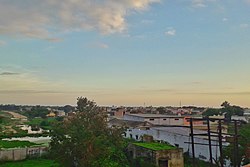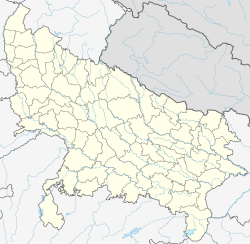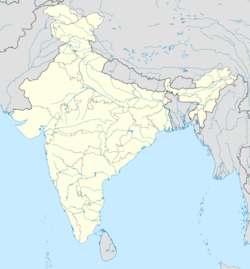Bulandshahr
Bulandshahr is a city and a municipal board in Bulandshahr district in the state of Uttar Pradesh, India.[3] It is the administrative headquarters of Bulandshahr District. According to the Government of India, the district Bulandshahr is one of the Minority Concentrated Districts of India on the basis of the 2011 census data on population, socio-economic indicators and basic amenities indicators.[4] The distance between Bulandshahr and New Delhi is 68 km.[5]
Bulandshahr | |
|---|---|
City | |
 Bulandshahr skyline | |
| Coordinates: 28°24′N 77°51′E / 28.4°N 77.85°ECoordinates: 28°24′N 77°51′E / 28.4°N 77.85°E | |
| Country | |
| State | Uttar Pradesh |
| District | Bulandshahr |
| Founded by | King Ahibaran |
| Area | |
| • Total | 64 km2 (25 sq mi) |
| Elevation | 195 m (640 ft) |
| Population (2011) | |
| • Total | 235,310[1] |
| • Density | 788/km2 (2,040/sq mi) |
| Language | |
| • Official | Hindi[2] |
| • Additional official | Urdu[2] |
| Time zone | UTC+5:30 (IST) |
| PIN | 203001 |
| Telephone code | 91 (5732) |
| Vehicle registration | UP-13 |
| Sex ratio | 1.892 ♂/♀ |
| Website | bulandshahar |
EtymologyEdit
An early history of Bulandshahr and its origin of name is given by British District magistrate and collector for the Indian Civil Service, Frederic Salmon Growse, in a paper titled "Bulandshahr Antiquities" published in the Journal of Asiatic Society of Bengal in 1879.[6] Bulandshahr was founded as 'Baran' by the king Ahibaran.[7]
Since it was perched on a highland it came to be known as "high city",[8] (Persian: بلند شهر), which translates as Bulandshahr in Persian language during the Mughal era.
HistoryEdit
Early historyEdit
Growse's discoveries in the 1880s showed that Baran was inhabited by Buddhists between 400 and 600AD.[9]
The kingdom of Baran came to an end probably during the 12th century. In 1192 CE when Muhammad Ghauri conquered parts of India, his general Qutubuddin Aibak surrounded Fort Baran and conquered it and the Raja Chandrasen Dodiya was killed and Aibak took control of the Baran kingdom.[citation needed]
The ancient ruins found at places in Bhatora Veerpur, Ghalibpur, etc. are indicative of the antiquity of Bulandshahr. There are several other important places in the District from where statues belonging to the medieval age and objects of ancient temples have been found. Even today, several of these historical and ancient objects such as coins, inscriptions etc. are preserved in the State Museum Lucknow.[citation needed]
British ruleEdit
Raja Lachhman Singh (1826-1896), who served the government from 1847 and wrote a Statistical Memoir of the Bulandshahr District, moved to Bulandshahr following retirement.[10][11]
The Indian Rebellion of 1857 is generally associated with the surrounding areas such Meerut, Delhi and Aligarh.[12] On 20 May 1857, the 9th regiment of Bulandshahr looted the treasury at Bulandshahr. Sir Alfred Comyn Lyall was subsequently appointed assistant magistrate of Bulandshahr, and Lord Roberts was also present in the district.[12][13][14]
Hindi scholar, archaeologist and district magistrate and collector of Bulandshahr from 1876 to 1884, Frederic Growse, resided at Collector's House, Bulandshahr.[15] In 1884 he published Bulandshahr; or, Sketches of an Indian district; social, historical and architectural.[16]
Raja Babu Park had been constructed in Bulandshahr in 1837, and a statue of Queen Victoria was placed there in 1901, when the park was renamed ‘Maharani Victoria Park’.[17]
Post-independenceEdit
Following India's independence, ‘Maharani Victoria Park’ was renamed after Shri Rajeshwar Dayal Saxena (Raja Babu), president of the Civil Bar Association and later president of Municipal Board, Bulandshahar. Later it was renamed again back to 'Raja Babu Park'. In 1969 a statue of ‘Mahatma Gandhi’was established in the park.[17]
GeographyEdit
The distance between Bulandshahr and New Delhi is 68 km.[5] It lies in the Bulandshahr District on the Agra to Delhi Road, and is surrounded by Delhi, Meerut, Moradabad, Badaun and Aligarh.[12]
DemographicsEdit
As per provisional data of 2011 census, Bulandshahr urban agglomeration had a population of 235,310, out of which males were 125,549 and females were 111,761. Population in the age groups of 0 to 6 years was 30,886. The total number of literates were 160,203, of which 90,761 were males and 69,442 were females. The effective literacy rate of 7+ population was 78.37%.[1]
Administration and politicsEdit
Bulandshahr is one of seven administrative sub-divisions of the District of Bulandshahr.[3]
BuildingsEdit
Bulandshahr has four gates; Bunford Club Gate, Fatehganj Gate, Growseganj Gate and Moti Bagh Gate.[17]
EventsEdit
The town hosts an annual exhibition known as 'numaish'.[18]
Notable peopleEdit
- Capt. Abbas Ali[19]
- Amit Bhadana[20]
- Kay Baxter[21]
- Sonal Chauhan[22]
- Banarasi Das[23]
- Jaiprakash Gaur[24]
- Saloni Gaur
- Arif Mohammad Khan[25]
- Bhuvneshwar Kumar, fast bowler in the Indian cricket team.
- Satish Kumar[26]
- Hitesh Kumari, former minister of UP irrigation department, and MLA from Debai assembly constituency.
- Gajendra Pal Singh Raghava, scientist expert in bioinformatics, winner of awards including Shanti Swarup Bhatnagar Prize for Science and Technology
- Arfa Khanum Sherwani, Indian journalist
- Kushal Pal Singh, CEO of DLF Limited, India's largest real estate developer.
- Neera Yadav, ex-officer of the Indian Administrative Service.
GalleryEdit
ReferencesEdit
- ↑ 1.0 1.1 "Urban Agglomerations/Cities having population 1 lakh and above" (PDF). Provisional Population Totals, Census of India 2011. Retrieved 7 July 2012.
- ↑ 2.0 2.1 "52nd Report of the Commissioner for Linguistic Minorities in India" (PDF). nclm.nic.in. Ministry of Minority Affairs. Archived from the original (PDF) on 25 May 2017. Retrieved 21 December 2018.
- ↑ 3.0 3.1 "District-Profile | District Bulandshahr, Government of Uttar Pradesh | India". Archived from the original on 17 April 2021. Retrieved 17 April 2021.
{{cite web}}:|archive-date=/|archive-url=timestamp mismatch (help) - ↑ "List of Minority Concentration Districts (Category 'A' & 'B')" (PDF). minorityaffairs.gov.in. Retrieved 25 February 2019.
- ↑ 5.0 5.1 "New Delhi, Delhi to Bulandshahr, Uttar Pradesh directions, best route map, conditions and traffic info". www.distancebetweencities.co.in. Retrieved 2 August 2015.
- ↑ Growse, F. S. (1879). "Bulandshahr Antiquities". Journal of Asiatic Society of Bengal: 270–276.
- ↑ Provinces (India), North-Western (1875). Statistical, Descriptive and Historical Account of the North-Western Provinces of India: Meerut division. v.2:pt.1. Saháranpur District. v.2:pt.2. Aligarh District. v.3:pt.1. Bulandshahr District. v.3:pt.2. Meerut (Mirath) District. v.3:pt.3. Muzaffarnagar District. Printed at the North-western Provinces' Government Press. p. 78.
- ↑ Uttar Pradesh District Gazetteers: Bulandshahr. Government of Uttar Pradesh. 1980.
- ↑ Nevill, H. R. (1922). District Gazetteers Of The United Provinces Of Agra And Oudh Bulandshar Vol-V. Lucknow: Government Branch Press. pp. 204–208.
- ↑ Buckland, C. E. (1971). Dictionary of Indian Biography. Ardent Media. p. 60.
- ↑ Growse, Frederic Salmon (1884). Bulandshahr: Or, Sketches of an Indian District: Social, Historical and Architectural. Benares: Medical Hall Press. p. 10.
- ↑ 12.0 12.1 12.2 Tewari, J. P. (1966). "The revolt of 1857 in Bulandshahr District". Proceedings of the Indian History Congress. 28: 365–376. ISSN 2249-1937.
- ↑ Mukherjee, Paresh Nath (1958). "Bulandshahr in 1857 rising". Proceedings of the Indian History Congress. 21: 496–500. ISSN 2249-1937.
- ↑ "Nawab Walidad Khan and the 1857 Struggle in the Bulandshahr district". The Peasant and the Raj: Studies in Agrarian Society and Peasant Rebellion in Colonial India. Cambridge University Press: 140–158. 1978.
- ↑ 15.0 15.1 15.2 15.3 "Indian Architecture of To-day as Exemplified in the New Buildings of Bulandshahr District, Part II · Highlights from the Digital Content Library". dcl.dash.umn.edu. Retrieved 17 April 2021.
- ↑ Journal of the Royal Asiatic Society of Great Britain and Ireland. Royal Asiatic Society of Great Britain & Ireland. 1893. pp. 650–652.
- ↑ 17.0 17.1 17.2 "Census of India 2011: Bulandshahr village and town directory". Series 10, PART XII-A.
- ↑ The Geographer. Aligarh Muslim University Geographical Society. 1982.
- ↑ "Freedom fighter Abbas Ali to support Arvind Kejriwal". The Hindu. 31 March 2014. Archived from the original on 12 April 2021. Retrieved 12 April 2021.
{{cite news}}:|archive-date=/|archive-url=timestamp mismatch (help) - ↑ Bose, Ajitabha. The Youtube Stars Of India: And their journey to stardom. Ajitabha Publishers. p. 39. ISBN 978-81-949914-3-4.
- ↑ Wilson, Derek (2004). "Baxter [née fforde], Kathleen Mary Carver [Kay]". Oxford Dictionary of National Biography (online ed.). OUP. doi:10.1093/ref:odnb/72210. Template:ODNBsub
- ↑ "All you want to know about #SonalChauhan". FilmiBeat. Archived from the original on 13 April 2021. Retrieved 13 April 2021.
{{cite web}}:|archive-date=/|archive-url=timestamp mismatch (help) - ↑ Brass, Paul R. An Indian Political Life: Charan Singh and Congress Politics, 1957 to 1967. SAGE Publications India. p. 405. ISBN 978-81-321-1715-5.
- ↑ Damodaran, Harish (2018). INDIA'S NEW CAPITALISTS: Caste, Business, and Industry in a Modern Nation. Hachette India. ISBN 978-93-5195-280-0.
- ↑ "Shri. Arif Mohammed Khan | Kerala Agricultural University". www.kau.edu. Retrieved 13 April 2021.
- ↑ "History-maker Satish Kumar at the nation's service". Olympic Channel. Archived from the original on 13 April 2021. Retrieved 13 April 2021.
{{cite web}}:|archive-date=/|archive-url=timestamp mismatch (help)
External linksEdit
- Bulandshahr: Or, Sketches of an Indian District: Social, Historical and Architectural. Frederic Salmon Growse, Benares (1884).

